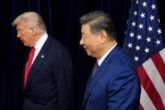June 11, 2025
Countering AI Chip Smuggling Has Become a National Security Priority
An Updated Playbook for Preventing AI Chip Smuggling to the PRC
Based on the available evidence, artificial intelligence (AI) chip smuggling has likely been occurring at a scale that significantly undermines U.S. attempts to restrict the People’s Republic of China’s (PRC’s) access to advanced AI. This is indicated by four lines of argument:
- Smuggling should be expected based on historical precedent. The PRC has a long history of smuggling U.S. technology despite export restrictions, which has rarely resulted in criminal or civil penalties.1
- Smuggling of U.S. AI chips is highly incentivized by their superior performance, higher supply, and more mature software ecosystem relative to chips legally available to Chinese AI labs.2 Based on publicly available data, of the 22 notable models that had been developed exclusively in the PRC by 2025, only two were trained with Chinese chips.3
- Six news outlets have independently reported evidence of large-scale AI chip smuggling, totaling tens to hundreds of thousands of chips smuggled in 2024. One smuggler reportedly handled an order of for servers containing 2,400 NVIDIA H100s—worth $120 million—to a customer in the PRC.4 Another facilitated an order worth $103 million.5 Singapore authorities arrested three individuals suspected of diverting AI servers worth $390 million.6 Within this reporting, multiple chip resellers and start-ups in the PRC have claimed that gaining access to export-controlled AI chips is straightforward, with one Chinese start-up founder estimating in 2024 that there were more than 100,000 NVIDIA H100s in the PRC.7 Most of the Chinese chip sellers interviewed in these reports confirm that they work with multiple distributors, use shell companies based overseas, and employ simple tactics to avoid detection, such as relabeling shipments as tea or toys.8
- There are many online listings for export-controlled AI chips available for purchase in the PRC. The authors conducted a non-exhaustive search of three Chinese online marketplaces and found 132 domestic listings for export-controlled chips, along with many photos of supposedly smuggled goods.9 Where sellers provided information on stock, the average quantity of export-controlled graphics processing units (GPUs) per listing was around 1,200 for GPU server listings and 400 for GPU card listings. Though this data is patchy and likely unreliable, the total stock implied is around 100,000 H100 GPUs, as of December 2024.
Across these data sources, there is much uncertainty in either direction. Using publicly available data from this reporting, while accounting for uncertainty about its veracity, the authors estimate the total scale of AI chip smuggling to the PRC in 2024 could have ranged anywhere from 10,000 to several hundred thousand chips, with a median estimate of around 140,000. This estimate is based on a probabilistic model of chip smuggling as an extrapolation of known cases. It should be understood as a high-level distribution of possible outcomes, rather than a summation of confirmed smuggling cases.10
If the true number is close to the median of this distribution, smuggled chips would make up a significant portion of AI compute acquired by the PRC in 2024—between 1 and 30 percent of its inference compute capacity (median 6 percent) or between 1 and 40 percent of its training compute capacity (median 10 percent). Other sources of PRC AI compute acquisition considered are Huawei Ascend chips fabricated by China’s Semiconductor Manufacturing International Corporation (SMIC) and Taiwan Semiconductor Manufacturing Company (TSMC), and NVIDIA H20 chips legally exported into the PRC. Because the export of the H20 was restricted in April 2025, and TSMC is under investigation for its role in fabricating chips for Huawei, smuggled chips may make up a much larger portion of AI compute acquired by the PRC in 2025 and beyond.11
Given the potential scale of AI chip smuggling to the PRC, policymakers should prioritize gathering information to better understand its true extent. Large-scale chip smuggling and uncertainty about its true extent exist partly because the Bureau of Industry and Security (BIS)—the part of government tasked with administering and enforcing AI chip export controls—is under-resourced. The BIS’s budget for enforcement has decreased in real terms over time, even after it was tasked with far more responsibilities in 2022 following Russia’s invasion of Ukraine and the introduction of a wide range of new export controls on AI chips and related tooling. The profits likely netted by chip smugglers from just three reported smuggling cases from The New York Times and The Information are more than double the BIS’s annual budget for export control enforcement.12
AI chip smuggling is a recent problem, and counterefforts remain limited. Moreover, AI chip companies typically lack the deep experience in exporting sensitive goods that exists, for example, in the defense industry. As a result, there are many promising steps that government and industry could take to solve this problem. The authors offer six recommendations:
- AI chip companies and their distributors should leverage their technical capacities and resources to significantly strengthen their due diligence processes, make similar requirements of any distribution firms to which they sell, and report to the BIS on specific measures taken.
- The BIS could use its existing authorities to create a new notification requirement for controlled AI chip exports, reexports, and ownership transfers. This would enable much better tracking of controlled chips exported outside the United States, allowing for more efficient enforcement.
- AI chip designers should implement software-based location verification features, allowing the owner of a controlled chip to prove that the chip is not located in the PRC. This would both provide valuable data on the scale of chip smuggling and provide a useful mechanism for enforcement, enabling knowledge of which specific devices have been smuggled, and knowledge of which exporters and downstream entities were responsible. BIS could incentivize the development of these features through the normal export licensing process today, by requiring chip owners outside the United States to periodically prove that their chips are not in the PRC as a condition for importing chips.
- The Department of Commerce, in coordination with the intelligence community (IC), could establish processes to generate information on the scale, locations, and perpetrators of AI chip smuggling, and share it with the BIS to aid enforcement, inform policy, and share leads with relevant industry actors. This could be facilitated through the Director for National intelligence (DNI) updating the National Intelligence Priorities Framework to make intelligence collection related to export control enforcement a top priority, and the DNI and Secretary of Commerce establishing a joint analysis team (for example, in the Export Control Enforcement Center) to facilitate BIS-IC coordination.
- Congress could authorize a whistleblower incentive program and qui tam lawsuits (lawsuits that allow a private person to prosecute on behalf of the government) to incentivize reports of possible export violations. These two measures could significantly boost the BIS’s export enforcement while paying for themselves in revenue generated through additional penalties. A whistleblower program could be modeled on the highly successful Securities and Exchange Commission (SEC) Whistleblower Program, which tackles federal securities laws violations and has aided the collection of $7 billion to $22 billion in penalties since 2011.13 In April 2025, a bipartisan bill was introduced in the Senate to implement such a program.14 Authorizing qui tam lawsuits against those who violate the export rules would additionally allow individuals to sue a violator and collect a portion of the resulting penalty, modeled on a similar law in the False Claims Act.
- Finally, Congress could grant the White House’s requested budget of $313 million for the BIS for fiscal year 2026. This 64 percent increase over the BIS’s current budget of $191 million would help the BIS modernize its tooling and improve operational capacity. In addition to strengthening national security, funding to improve the enforcement of the AI chip controls would likely pay for itself through increased collection of fines on violators of the export rules. The multiple documented instances of AI chip smuggling from 2024 alone could each have resulted in penalties of over $200 million, more than the BIS’s annual budget.
As controlling access to advanced AI capabilities becomes an increasing national security imperative, U.S. policymakers should prioritize actions to collect more reliable information on the extent of AI chip smuggling and close gaps wherever possible.
Download the Full Report
- Hugo Meijer, Trading with the Enemy: The Making of US Export Control Policy Toward the People's Republic of China (New York: Oxford University Press, 2016); Ryan Fedasiuk, Karson Elmgren, and Ellen Lu, Silicon Twist: Managing the Chinese Military’s Access to AI Chips (Center for Security and Emerging Technology, June 2022), https://cset.georgetown.edu/publication/silicon-twist/; “Special Report: How U.S.-Made Chips Are Flowing into Russia,” Nikkei Asia, April 11, 2023, https://asia.nikkei.com/Business/Tech/Semiconductors/Special-report-How-U.S.-made-chips-are-flowing-into-Russia. ↩
- Fanny Potkin, “Exclusive: Huawei Aims to Mass-Produce Newest AI Chip in Early 2025, Despite US Curbs,” Reuters, November 21, 2024, https://www.reuters.com/technology/artificial-intelligence/huawei-aims-mass-produce-newest-ai-chip-early-2025-despite-us-curbs-2024-11-21/; Eleanor Olcott, Ryan McMorrow, and Tina Hu, Huawei’s Bug-Ridden Software Hampers China’s Efforts to Replace Nvidia in AI,” Financial Times, September 3, 2024, https://www.ft.com/content/3dab07d3-3d97-4f3b-941b-cc8a21a901d6. ↩
- “Notable models” are defined as models that were state of the art at the time of release, highly cited, or otherwise historically significant. Only models that had information about the hardware used to train them were included. “Notable AI Models,” Epoch AI, June 19, 2024, updated February 13, 2025, https://epoch.ai/data/notable-ai-models. ↩
- Qianer Liu, “Nvidia AI Chip Smuggling to China Becomes an Industry,” The Information, August 12, 2024, https://www.theinformation.com/articles/nvidia-ai-chip-smuggling-to-china-becomes-an-industry. ↩
- Ana Swanson and Claire Fu, “With Smugglers and Front Companies, China Is Skirting American A.I. Bans,” The New York Times, August 4, 2024, https://www.nytimes.com/2024/08/04/technology/china-ai-microchips.html. ↩
- Xinghui Kok, “Singapore Charges Three With Fraud That Media Link to Nvidia Chips,” Reuters, February 28, 2025, https://www.reuters.com/technology/singapore-charges-three-with-fraud-that-media-link-nvidia-chips-2025-02-28/; Reuters, “Singapore Prosecutors Say US Server Fraud Case Involves $390 Million of Transactions,” Reuters, March 13, 2025, https://www.reuters.com/world/asia-pacific/singapore-prosecutors-says-us-servers-fraud-case-involves-390-million-2025-03-13/. ↩
- Ryan McMorrow and Eleanor Olcott, “Nvidia's AI Chips are Cheaper to Rent in China Than US,” Financial Times, September 6, 2024, https://www.ft.com/content/10aacfa3-e966-4b50-bbee-66e13560deb4. ↩
- Swanson and Fu, “With Smugglers and Front Companies, China Is Skirting American A.I. Bans”; Liu, “Nvidia AI Chip Smuggling to China Becomes an Industry.” ↩
- See an overview of listings that contained images here: https://docs.google.com/spreadsheets/d/1eOYMu7va2TV1bi58EFivnUC__rVk9eYHJoCoowjiIdc. ↩
- Monte Carlo simulations are used to simulate a range of possible outcomes from the two distinct large-scale smuggling pathways that the authors see as most likely. In the first pathway, smugglers use shell companies to reexport relatively low volumes of AI chips purchased from resellers in various third countries. In the second pathway, smugglers set up real cloud service providers as front companies in third countries, use those to purchase relatively large volumes of AI chips directly from server builders and/or AI chip makers, and reexport a portion of the purchased chips. The model’s input parameters, such as the number of cloud provider fronts and order volumes, are grounded in real-world data whenever possible, although with substantial uncertainty, given the limited data available. For full methodology and results, see Appendix A, as well as Timothy Fist & Erich Grunewald, “AI Chip Smuggling Estimates (for 2024),” Google Colab, https://colab.research.google.com/drive/1ZxiwsHjc_aYh2N3Fzy2x7fg_nkjoYh2J. ↩
- Stephen Nellis and Karen Freifeld, “Nvidia Faces $5.5 Billion Charge as US Restricts Chip Sales to China,” Reuters, April 17, 2025, https://www.reuters.com/technology/nvidia-expects-up-55-billion-charge-first-quarter-2025-04-15/; Reuters, “TSMC Says It Has Alerted US of Potential China AI Chip Curbs Violation,” Reuters, October 22, 2024, https://www.reuters.com/technology/artificial-intelligence/tsmc-says-it-has-alerted-us-potential-china-ai-chip-curbs-violation-information-2024-10-22/; Karen Freifeld, “Exclusive: TSMC could face $1 billion or more fine from US probe, sources say,” Reuters, April 8, 2025, https://www.reuters.com/technology/tsmc-could-face-1-billion-or-more-fine-us-probe-sources-say-2025-04-08. ↩
- $55 million vs $140 million. See Figures 6 and 11. Data from “Fiscal Year 2025 President's Budget Request,” March 31, 2024, https://www.commerce.gov/sites/default/files/2024-03/BIS-FY2025-Congressional-Budget-Submission.pdf; Swanson and Fu, “With Smugglers and Front Companies, China Is Skirting American A.I. Bans”; Liu, “Nvidia AI Chip Smuggling to China Becomes an Industry.” ↩
- According to the annual SEC report, whistleblowers have been awarded over $2.2 billion since the program began in 2011. Because whistleblowers can receive between 10 and 30 percent of the overall penalty, the total penalties associated with these rewards range from at least $7 billion to at most $22 billion. “Securities and Exchange Commission Office of the Whistleblower Annual Report to Congress for Fiscal Year 2024,” Securities and Exchange Commission Office of the Whistleblower, October 15, 2024, accessed May 17, 2025, https://www.sec.gov/files/fy24-annual-whistleblower-report.pdf. ↩
- “Rounds Introduces Legislation to Prevent Smuggling of American AI Chips Into China,” Mike Rounds, April 10, 2025, https://www.rounds.senate.gov/newsroom/press-releases/rounds-introduces-legislation-to-prevent-smuggling-of-american-ai-chips-into-china. ↩
More from CNAS
-
Transatlantic Security / Technology & National Security
Look Before We Leap on Artificial IntelligenceThis article was originally published on The Dispatch. A debate about the role that artificial intelligence should and will play in society, and how it will affect humanity fo...
By Jon B. Wolfsthal
-
Technology & National Security
Caleb Withers on the Cybersecurity Frontier in the Age of AICaleb Withers, research associate at the Center for a New American Security, joins Kevin Frazier, the AI Innovation and Law Fellow at the University of Texas School of Law and...
By Caleb Withers
-
Technology & National Security
Prepared, Not ParalyzedExecutive Summary The Trump administration has embraced a pro-innovation approach to artificial intelligence (AI) policy. Its AI Action Plan, released July 2025, underscores t...
By Janet Egan, Spencer Michaels & Caleb Withers
-
Indo-Pacific Security / Technology & National Security
Sharper: Tech + ChinaRecent talks between President Donald Trump and Chinese Communist Party General Secretary Xi Jinping placed a spotlight on emerging technologies, from high-end chips to minera...
By Charles Horn & Sevi Silvia






